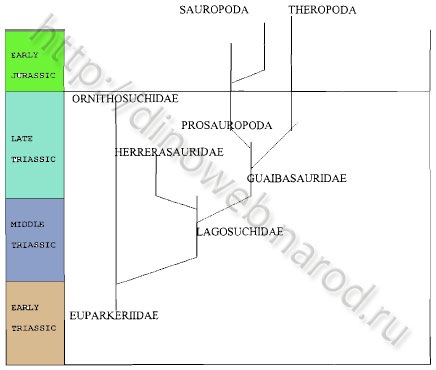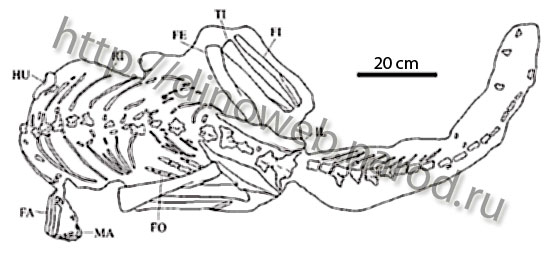Genus: Guaibasaurus Bonaparte, Ferigolo, Ribeiro, 1999
Classification: Dinosauria - Saurischia - Theropoda - Herrerasauria - Guaibasauridae
Etymology: After the "Rio Guaiba Hydrographic Basin", where the fossil was collected as a part of the "Pro-Guaiba Project", a scientific program supporting research on Triassic fossils.
Synonyms: none
Type species: G. candelariensis Bonaparte, Ferigolo, Ribeiro, 1999
Other Species: none
Diagnosis: as for the type species
Species: Guaibasaurus candelariensis Bonaparte, Ferigolo, Ribeiro, 1999
Etymology: "candelariensis" after Candelaria, the city near the fossil locality, where the holotype was collected.
Synonyms: none
Holotype: MCN-PV 2355, consisting of five incomplete dorsal centra, three incomplete dorsal neural arches, two incomplete sacral centra; ten almost complete and articulated caudals with haemal arches; five incomplete dorsal ribs; a left, incomplete scapula and coracoids; a fragment of the left and the almost complete right ilium; nearly complete pubes; both incomplete ischia; both incomplete femora; both incomplete tibiae and fibulae; both feet with fragmentary tarsals, except for a complete right calcaneum.
Referred Specimens:
Hypodigm: The holotype and the specimen MCN-PV-2356, consisting of incomplete left tibia and fibula, articulated with a complete foot, including proximal and distal tarsals, five metatarsals and phalanges. It is identified with the holotype based on the feet preserved in both specimens.
UFRGS PV0725T, fairly complete, articulated skeleton lacking the skull, jaws, and neck. It is an articulated specimen including most of the bones except the cervical vertebrae, skull and lower jaws,
which apparently were destroyed by erosion. The specimen is resting on its ventral side, with each hind and fore limb flexed. It is preserved in the original position in which it died, without evidence of movement of the bones except by some slight alteration of the original position after the soft parts apparently dried. Ribs, gastralia, phalanges, vertebrae and haemal arches remained undisturbed. Unfortunately the integrity of the bones was affected by diagenesis in different proportions although it does not preclude accurate reconstructions of most of them (Bonaparte,Brea, Schultz, & Martinelli, 2006).
Time: early Late Triassic (Norian)
Horizon: Caturrita Formation
Location: Holotype - 100 meters south of RS 287 (RS State Highway), 7.5 km west to the city of Candelaria, RS, Brazil. The specimen UFRGS PV0725T was collected at a quarry for road metal located 2 km northeast from the city of Faxinal do Soturno, State of Rio Grande do Sul, southern Brazil.
Total length: ~ 1.5 m.
Mass: 40-80 kg.
Diagnosis: The combination of the following primitive and derived characters distinguish Guaibasaums candelariensis from all other taxa: midanterior dorsal neural arches with large pneumatic cavities; a parapophysial-prezygapophysial lamina with a fossa below it; an undivided infradiapophysial lamina, the presence of hyposphene-hypantrum; a sacral centrum double the volume of the following one; a slender scapula with a distal expansion; the acetabular area of the ilium closed or nearly so, with only an incipient reduction of its medial wall; ilium with a dorsoventrally deep posterior projection, an
extremely large crista supracetabularis; and a well developed fossa brevis; elongated and slender ischium with a triangular cross section, possessing a long symphysis, and with a dorsoventrally flat distal expansion; laminar and elongated pubes with a pronounced proximolateral trochanter; a femur with a small anterior trochanter; a lateroposterior ridge lying above the level of the anterior trochanter and absence of trochanteric shelf; a tibia nearly as long as the femur, with quadrangular distal cross section, and a well defined posteroventral projection; a large astragalus with a well defined dorsal process; a narrow, small calcaneum with a pronounced ventromedial process; two distal tarsals; a reduced fifth metatarsal, lacking phalanges; and an unreduced metatarsal one (Bonaparte, Ferigolo, Ribeiro, 1999).
Emended diagnosis. The species is diagnosed by the following combination of character states: dorsal vertebrae with centra longer than high, transversely flat and low neural spines, robust posterior infradiapophysial border directed posteroventrally and an anterior, slender one directed anteroventrally. First sacral centrum much larger than the second and third. Ilium with a short, conical, preacetabular process; acetabulum almost closed, with a pronounced crista supracetabularis; laminar pubis; and elongate ischium with a triangular cross section and a modest distal expansion. Hind limb, similar to that of Saturnalia, but more slender; tibia and femur of similar length; calcaneum transversely narrow with a ventromedial process, different from that of Saturnalia. Metatarsal I longer and metatarsal III shorter than in Saturnalia. Humerus, radius and ulna resemble those of basal sauropodomorphs and theropods, but the manus is narrow and elongate as in Coelophysis, without hyperthrophy of the first digit (Bonaparte,Brea, Schultz, & Martinelli, 2006).
Comments: Two incomplete specimens of a new genus and species of Saurischia, Guaibasaurus candelariensis, from the Caturrita Formation of Rio Grande do Sul, southern Brazil, offers new data on the basal dinosaurs and a new interpretation of the early evolution of the Saurischia. The new taxon is more primitive than the Herrerasauridae, in the structure of the dorsal vertebrae, ilium, pubis, femur, tarsus and foot. The mesotarsal condition and the outline of the distal section of tibia indicate the saurischian nature of this new form, but the almost unreduced medial wall of the acetabular portion of ilium shows an unrecorded primitive condition within the cited group. These particular characters lead us to propose a new family: the Guaibasauridae. Several features suggesting affinities with both the Prosauropoda and Theropoda, imply that Guaibasaurus candelariensis may belong to the ancestral group for both of them (Bonaparte, Ferigolo, Ribeiro, 1999).
Although evidences does not exist to decide unequivocally if Guaibasaurus candelariensis was a carnivorous Saurischia, we consider that it possibly was. The reason is that the primitive saurischians were carnivorous before their split into Sauropodomorpha and Theropoda. In addition, some characters such as the high position of the fourth trochanter, the dorsal crest of the femur running distally from the anterior trochanter, and the subquadrangular cross section of the distal end of the tibia fit well with characters recorded in Triassic theropods. Carnivorous or omnivorous, Guaibasaurus possesses a group
of characters more primitive than those of the Herrerasauridae, and more derived than in "Lagosuchus"-Marasuchus, making it a suitable ancestral group to both the Sauropodomorpha and the Theropoda.
The association of the following characters of Guaibasaurus support the interpretation that it may belong to the ancestral group of the Sauropodomorpha.
1) Elongate, massive ischium with a long symphysis and a distal expansion.
2) Elongate, straight pubis with lateroproximal process for the ambiens muscle (present in Efraasia and to a lesser degree in Riojasaurus).
3) Presence of a moderately developed anterior trochanter on the femur.
4) A dorsoventrally elongated fourth trocanter, with a medial depression for muscular attachment.
5) A straight femur in anterior view.
6) The Posterior side of the distal section of the tibia located in a more lateral position than the anterior side, resulting in an oblique direction of the internal side of the tibia (comparable to Riojasaurus)
7) A Reduced ventromedial projection of the calcaneum.
8) An unreduced Metatarsal I.
9) Metatarsal V reduced to half the length of metatarsal IV.
If Guaibasaurus, and the Guaibasauridae, are part of an ancestral group to the Sauropodomorpha and, at the same time more primitive than the Herrerasauridae, its inferred position as the ancestral group of both Sauropodomorpha and Theropoda is a reasonable possibility. In the present study we do not see any serious, detailed argument to link the Guaibasauridae with the Ornithischia. (Bonaparte, Ferigolo, Ribeiro, 1999).
The phylogenetic position of Guaibasaurus is more controversial. Bonaparte et al. (1999) included the taxon within Saurischia, suggesting its closer relation to sauropodomorphs and theropods than to herrerasaurids. This hypothesis is supported by the present analysis, but Bonaparte et al. (1999) also listed several characters linking Guaibasaurus to sauropodomorphs. Among these, a well-developed ambiens process and an unreduced metatarsal I are plesiomorphic for Dinosauria. Likewise, most basal members of the group possess a straight femur (in cranial aspect), a moderately developed cranial trochanter, an elongate fourth trochanter with a medial depression (i.e., insertion of M. caudofemoralis longus), and a reduced metatarsal V. As indicated by Bonaparte et al. (1999), however, the distal tibia of Guaibasaurus has a craniocaudally compressed lateral margin, and the projections of its calcaneum are reduced. These are, indeed, apomorphic features within Dinosauria, found as they are in both ornithischians and theropods. In addition, a distally expanded massive ischium with a long symphysis is a eusaurischian apomorphy.
In conclusion, there is no strong evidence to support the sauropodomorph affinity of Guaibasaurus. Instead, the present analysis found it to represent the most basal theropod. The support for this hypothesis, however, is weak, with few apomorphic features supporting the arrangement. The precise phylogenetic position of Guaibasaurus is therefore still ambiguous, although it is clearly more closely related to eusaurischians than to herrerasaurids. Moreover, if considered a theropod, Guaibasaurus is also the most basal member of the group since it lacks most synapomorphies of more derived Theropoda (Langer, 2004).
The comparison of the anatomy of a second incomplete skeleton of Guaibasaurus candelariensis to that of basal Saurischia suggests that the origin of the “Prosauropoda” was from unknown basal saurischians, after separating from theropods (except herrerasaurids). Guaibasaurus and Saturnalia are part of this early dichotomy, and they bear mixed characters-states of basal theropods and “prosauropods” type. The Late Triassic age of both Guaibasaurus and Saturnalia (the latter is older) predates the ‘dominance’ of basal sauropodomorphs as well as the appearance of the basal theropod Zupaysaurus, both recorded from the upper Los Colorados Formation of Argentina (Bonaparte,Brea, Schultz, & Martinelli, 2006).
Bonaparte et al. (1999) suggested that Guaibasaurus may belong to the unknown ancestral group of both Theropoda and “prosauropoda”. Langer (2004) considered Guaibasaurus and Eoraptor within the
same unnamed clade, but Eoraptor is a quite juvenile specimen and its character states probably were affected by ontogeny. Apart from that, the close systematic position between Guaibasaurus and Saturnalia as basal eusaurischians is a good indication that both Bonaparte et al. (1999) and Langer (2004) have a basically similar systematic interpretation on these Late Triassic early saurischians.
The new information available suggests that the Guaibasauridae (Bonaparte et al. 1999), show more theropod-like characters than sauropodomorph-like characters. This evidence allows us to admit that
theropod-like basal saurischians gave rise to the guaibasaurid level of organization. So, guaibasaurids may represent basal saurischians on the stem-lineage to Sauropodomorpha (Langer 2003; 2004), or the ancestral group to Theropoda and “prosauropoda” as stated by Bonaparte et al. (1999). (Bonaparte,Brea, Schultz, & Martinelli, 2006).
Illustrations:
Possible phylogenetic relationships of the Guaibasauridae with the Late Triassic Saurischians. Ornithischians are not included. The anatomical discussion and the comparisons made suggest that the Guaibasauridae is a suitable ancestral group to both Prosauropoda and the Theropoda, excluded the Herrerasauridae. The latter appears to be a sterile lineage with precocious derived characters (modified from Bonaparte, Ferigolo, Ribeiro, 1999).

Guaibasaurus candelariensis (UFRGS PV 0725T). Partial articulated skeleton in dorsal view with each hind limb flexed on each side. Scale bar represents 200mm. Abbreviations: FA, forearm; FE, femur; FI, fibula; FO, foot; HU, humerus; IL, ilium; MA, manus; RI, rib; TI, tibia (modified from Bonaparte,Brea, Schultz, & Martinelli, 2006).

Guaibasaurus candelariensis skeleton.

References:
Bonaparte JF, Ferigolo J, Ribeiro AM. 1999. A new early Late Triassic saurischian dinosaur from Rio Grande do Sul State, Brazil. Proceedings of the second Gondwanan Dinosaurs symposium. National Science Museum Monographs, Tokyo 15: p 89–109.
Langer MC. 2004. Basal Saurischia. In:Weishampel DB, Dodson P, Osmolska H, editors. The Dinosauria. The University of California Press. p 25–46.
Bonaparte, J. F., G. Brea, C. L. Schultz, & A. G. Martinelli, 2006. A new specimen of Guaibasaurus candelariensis (basal Saurischia) from the Late Triassic Caturrita Formation of southern Brazil. Historical Biology, 1–10.
© Tetrapoda Database Roman Ulansky roman.ulansky@gmail.com or adios85@mail.ru
|




